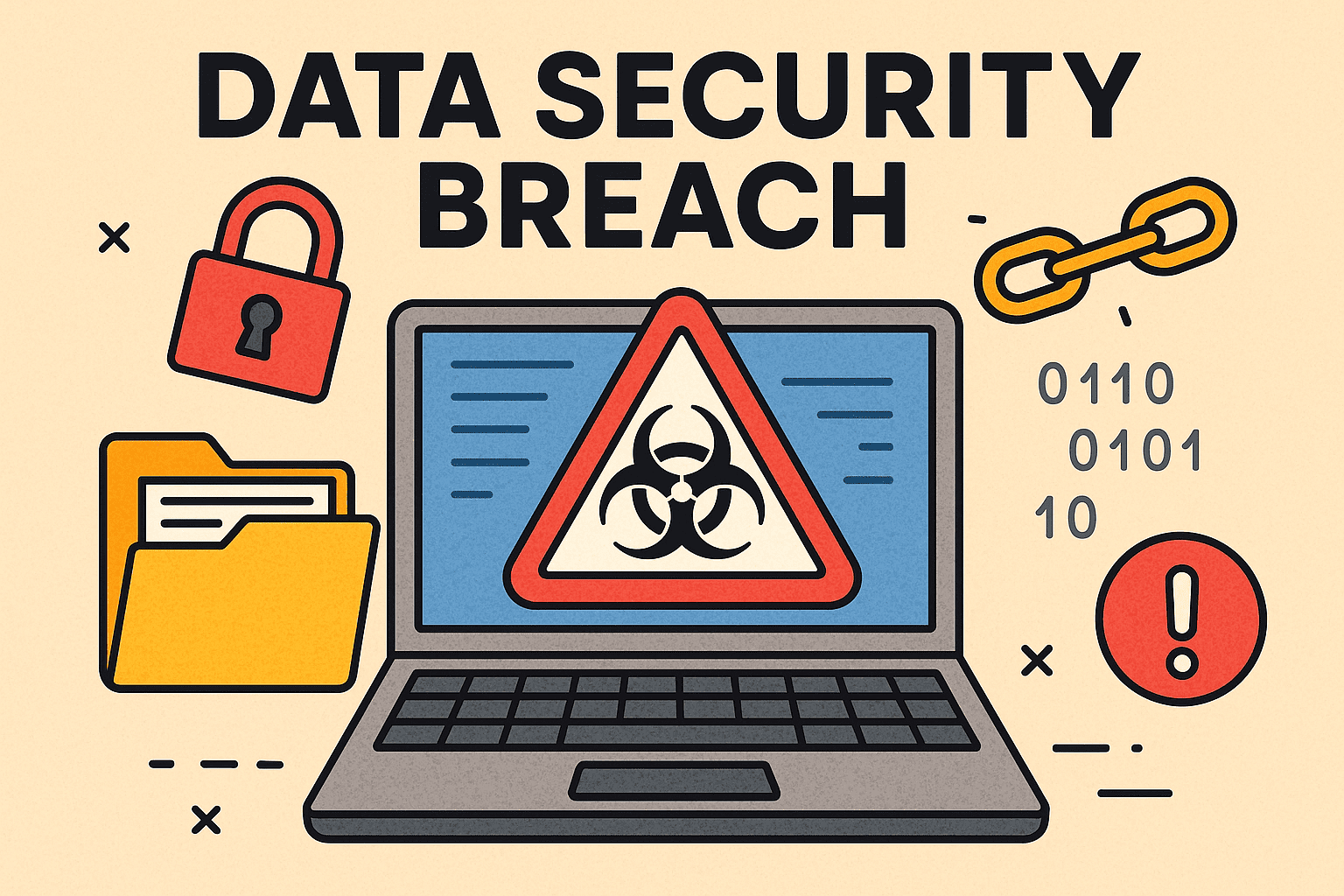Updated on October 15, 2025, by OpenEDR
Did you know that the average cost of a data security breach in 2023 reached $4.45 million, according to IBM? For IT managers, CEOs, and cybersecurity professionals, a data security breach is more than a technical issue—it’s a business crisis.
Introduction: Why Data Security Breaches Are Every Leader’s Nightmare
When confidential information such as customer records, financial data, or intellectual property is exposed, it can lead to reputation damage, legal penalties, and loss of trust. Understanding the causes, impacts, and prevention strategies is critical for every industry.
In this article, we’ll explore what a data security breach is, why it happens, and how to protect your organization against it.
1. What Is a Data Security Breach?
A data security breach occurs when unauthorized individuals gain access to sensitive, confidential, or protected information. This could involve personal data (PII), financial records, health information, or trade secrets.
Key Characteristics of a Data Breach:
Involves unauthorized access or disclosure of data.
Can be intentional (cyberattacks) or accidental (employee mistakes).
Often results in financial loss and reputational harm.
Requires immediate incident response and regulatory reporting.
👉 Simply put, a breach means that confidential data is no longer secure.
2. Common Causes of Data Security Breaches
Data breaches don’t just happen—they’re the result of weaknesses in systems, processes, or human behavior.
Top Causes Include:
Phishing Attacks: Employees tricked into revealing credentials.
Weak Passwords: Reused or easily guessed passwords give attackers access.
Malware & Ransomware: Malicious software infiltrates systems.
Unpatched Systems: Outdated software with known vulnerabilities.
Insider Threats: Employees misusing access rights.
Lost or Stolen Devices: Laptops, phones, or drives with sensitive data.
👉 In many cases, breaches are preventable with better controls and awareness.
3. Real-World Examples of Data Security Breaches
Examining real breaches shows the scale of the problem:
Equifax (2017): 147 million records exposed due to unpatched software.
Yahoo (2013–2014): 3 billion accounts compromised, one of the largest breaches in history.
Target (2013): Attackers gained access through a third-party vendor.
Marriott (2018): 500 million customer records compromised over several years.
👉 These cases highlight the importance of patching, vendor security, and monitoring.
4. Consequences of a Data Security Breach
The fallout from a breach is severe and often long-lasting.
Business Impacts Include:
💸 Financial Losses: Direct costs of investigations, fines, and legal fees.
🛑 Operational Disruption: Systems taken offline during containment.
📉 Reputation Damage: Customers lose trust and churn increases.
⚖️ Regulatory Penalties: GDPR, HIPAA, or PCI DSS fines.
🔍 Litigation: Class-action lawsuits from customers or partners.
👉 A breach is not just an IT issue—it’s a business-wide crisis.
5. How to Detect a Data Breach Early
The faster a breach is detected, the lower the damage.
Signs of a Breach:
Unusual login activity (e.g., logins from strange locations).
Sudden spikes in network traffic.
Disabled security tools or logs being deleted.
Complaints from customers about suspicious activity.
Alerts from security monitoring systems.
👉 Early detection saves millions in recovery costs.
6. Preventing Data Security Breaches
Prevention is always better than remediation. IT managers must implement multi-layered defense strategies.
Best Practices:
Strong Authentication: Enforce MFA and complex passwords.
Regular Patching: Keep all systems updated.
Network Segmentation: Limit the spread of attacks.
Employee Training: Teach staff to spot phishing and scams.
Encryption: Protect sensitive data at rest and in transit.
Access Controls: Follow the principle of least privilege.
Incident Response Plan: Ensure rapid containment and recovery.
👉 With layered defenses, breaches become much harder for attackers.
7. Role of Cybersecurity Tools in Preventing Breaches
Technology plays a huge role in modern defense.
Endpoint Detection & Response (EDR): Detects advanced threats.
Security Information & Event Management (SIEM): Monitors logs for anomalies.
Firewalls & IDS/IPS: Block unauthorized network access.
Data Loss Prevention (DLP): Prevents sensitive data leaks.
Zero Trust Security: Assumes no device or user is automatically trusted.
👉 Modern security stacks must combine prevention, detection, and response.
8. Compliance and Legal Considerations
A data security breach can also trigger compliance obligations.
GDPR (Europe): Requires reporting breaches within 72 hours.
HIPAA (Healthcare): Protects patient data; violations carry heavy fines.
PCI DSS (Finance): Governs payment card security.
CCPA (California): Protects consumer privacy rights.
👉 Failure to comply can result in millions in fines and penalties.
Quick Recap: Data Security Breach Essentials
✅ A data security breach is unauthorized access to sensitive data.
✅ Common causes include phishing, weak passwords, and malware.
✅ Impacts include financial loss, legal fines, and reputation damage.
✅ Prevention requires multi-layered security strategies.
✅ Compliance laws mandate rapid breach reporting and protection.
FAQs on Data Security Breaches
1. What is a data security breach in simple terms?
It’s when someone gains unauthorized access to sensitive or confidential data.
2. How do most data breaches happen?
They usually occur through phishing, malware, insider threats, or weak security controls.
3. What should a company do after a data breach?
Contain the breach, notify stakeholders, investigate the cause, and strengthen defenses.
4. Are small businesses at risk of breaches?
Yes—small businesses are often targeted because they lack robust security measures.
5. How can companies prevent data breaches?
By using strong authentication, employee training, monitoring tools, and encryption.
Final Thoughts
A data security breach is one of the most serious threats organizations face today. While technology enables growth and innovation, it also expands the attack surface. IT leaders and CEOs must adopt preventive strategies, advanced detection tools, and employee awareness programs to minimize the risk.
🚀 Want to stay ahead of attackers and secure your data from breaches?
Request a demo from Xcitium’s OpenEDR today and discover how advanced cybersecurity solutions protect your business.
